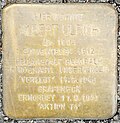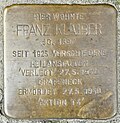Stumbling blocks in Tuttlingen

The stumbling blocks in Tuttlingen are special paving stones in sidewalks that are intended to commemorate the victims of the National Socialist dictatorship in the city of Tuttlingen in the Baden-Württemberg district of Tuttlingen in Germany .
Stumbling blocks
The Stolpersteine are a project by the artist Gunter Demnig . These small memorial plaques are intended to commemorate the fate of the people who were murdered, deported , expelled or driven to suicide during National Socialism .
Stumbling blocks are cubic concrete blocks with an edge length of ten centimeters, on the top of which there is an individually labeled brass plate . As a rule, they are set into the pavement at the same level in front of the last freely chosen houses of the Nazi victims . There are now over 61,000 stones (as of July 2017) not only in Germany, but also in 21 other European countries. The Stolpersteine are the largest decentralized memorial in the world.
At the end of 2014, the Tuttlingen municipal council agreed to have stumbling blocks laid in the city. Since relatively few Jews lived in Tuttlingen, the first phase was to remember people who were expelled from their homes by the euthanasia measures of the Nazis. In May 2016, Gunter Demnig laid the first stumbling blocks in Tuttlingen.
| image | inscription | address | Laying date |
Short biography |
|---|---|---|---|---|
ALBERT ULRICH JG LIVED HERE . 1904 DISTRIBUTED 1912 HEGGBACH HOSPITAL CHILDREN'S ASYLUM INGERKINGEN 'RELOCATED' 9/11/1940 GRAFENECK MURDERED 9/11/1940 'ACTION T4' |
At Seltenbach 2 Stolperstein | May 24, 2016 | Albert Ulrich , born on March 4, 1904, the eldest son of the Talheim woodcutter Heinrich Ulrich and his wife Maria Agathe Biermann, suffered from rickets as a child . When he was about to start school, he came, on medical advice, to a home run by the merciful sisters of the Reute monastery . As an adult he was transferred to the Heggbach nursing home . In September 1940 he was taken to the Grafeneck killing center with 193 other inmates and murdered there. | |
| THE DISTRICT COURT PRISON ANONI MIDINSKI JG. 1898 RUSSIA FORCED LABOR CAMP Muehlau ARRESTED FROM GUARD slain 02/28/1943 |
At Seltenbach 15 Stolperstein | May 24, 2016 | Anoni Midinski was born on July 13, 1898 in Werbowics near Kamyanets -Podilskyj in western Ukraine . Later he was one of around 2.75 million civilians who were deported from the Soviet Union to work in Germany. He came to Tuttlingen and lived in the “Mühlau” prisoner of war camp. Midinski was arrested for allegedly refusing to work and died of injuries inflicted by a prison guard. | |
| Held here AMTSGERICHT PRISON REINHOLD RALL JG. 1907 ARRESTED IN THE RESISTANCE JULY 1934 'DISTRIBUTION OF POLITICAL PUBLICATIONS' DEAD August 6th, 1934 CAUSE OF DEATH NEVER DETERMINED |
At Seltenbach 15 Stolperstein | May 24, 2016 | Reinhold Rall was born on July 6, 1907 in Tuttlingen as the son of the shoe factory worker Johannes Rall and his wife Pauline. His family was close to the Communist Party of Germany (KPD). Reinhold and some of his brothers were organized in the party. During a house search Reinhold Rall found communist writings, he was imprisoned in the Tuttlingen District Court prison and died on the night of August 5th to 6th, 1934, presumably of the consequences of mistreatment in his prison cell. | |
FRANZ KLAIBER JG LIVED HERE . 1897 SINCE 1925 DIFFERENT MEDICAL INSTITUTIONS 'RELOCATED' May 17, 1940 GRAFENECK MURDERED May 27, 1940 'ACTION T4' |
Donaustraße 9 Stolperstein | May 24, 2016 | Franz Klaiber was born on December 5, 1897 in Tuttlingen as the son of the shoemaker Christian Klaiber and his wife Anna Maria. After finishing school he worked as a worker in a shoe factory. Klaiber could not get rid of several experiences as a soldier in the First World War , nevertheless he took up his profession again after the war, married Maria Emhardt from Hundersingen and started a family with her. But the nervous ailments returned: from 1925 Franz Klaiber was admitted to various sanatoriums, most recently to the Weissenau sanatorium near Ravensburg . From there Klaiber 1940 with the gray buses in the grafeneck brought and killed. | |
PAULINE DOLD GEB. LIVED HERE KOSSMANN JG. 1888 SINCE 1924 VARIOUS MEDICAL INSTITUTIONS 'RELOCATED' 13.8.1940 GRAFENECK MURDERED 13.8.1940 'ACTION T4' |
Rathausstrasse 10 Stolperstein | May 24, 2016 | Pauline Dold born Kossmann was born on September 1, 1888, the fourth of twelve children of the “Schlüssel” landlord and brewery owner Johann Konrad Koßmann and Maria Barbara. In 1919 she married the factory director Robert Dold, also from Tuttlingen. Pauline Dold became mentally ill after the birth of her second child and spent a long time in various clinics. After her husband's death, she was sent to the Zwiefalten mental hospital for good. On August 13, 1940, Pauline Dold was brought to the Grafeneck killing center by the SS and murdered there. |
literature
- Joachim Rönneper : On my doorstep. “Stumbling blocks” by Gunter Demnig. A companion book . Arachne-Verlag, Gelsenkirchen 2010, ISBN 978-3-932005-40-4 .
Web links
Individual evidence
- ↑ In #Turin (Italy) the 50,000th #Stolperstein in Europe was laid today! He is reminiscent of Eleonora Levi. #Demnig @_Stolpersteine_ on January 11, 2015 on Twitter.
- ↑ Andreas Nefzger: The trace layer. In: FAZ.net . February 7, 2014, accessed December 16, 2014 .
- ↑ Article “ Tuttlinger Gemeinderat für Stolpersteine ” in Südwest Presse / “Die Neckar Quelle online”, November 18, 2014; accessed on September 3, 2017
- ^ " Gunter Demnig relocates five stumbling blocks - remembrance of Tuttlingen victims of the Nazi dictatorship " on www.tuttlingen.de; accessed on September 3, 2017
- ↑ Article " Tuttlingen lets stumbling blocks be laid " in Badischer Zeitung , May 24, 2016; accessed on September 3, 2017
- ↑ Article “ The first stumbling blocks have been laid ” in Schwäbischer Zeitung , May 25, 2016; accessed on September 3, 2017




